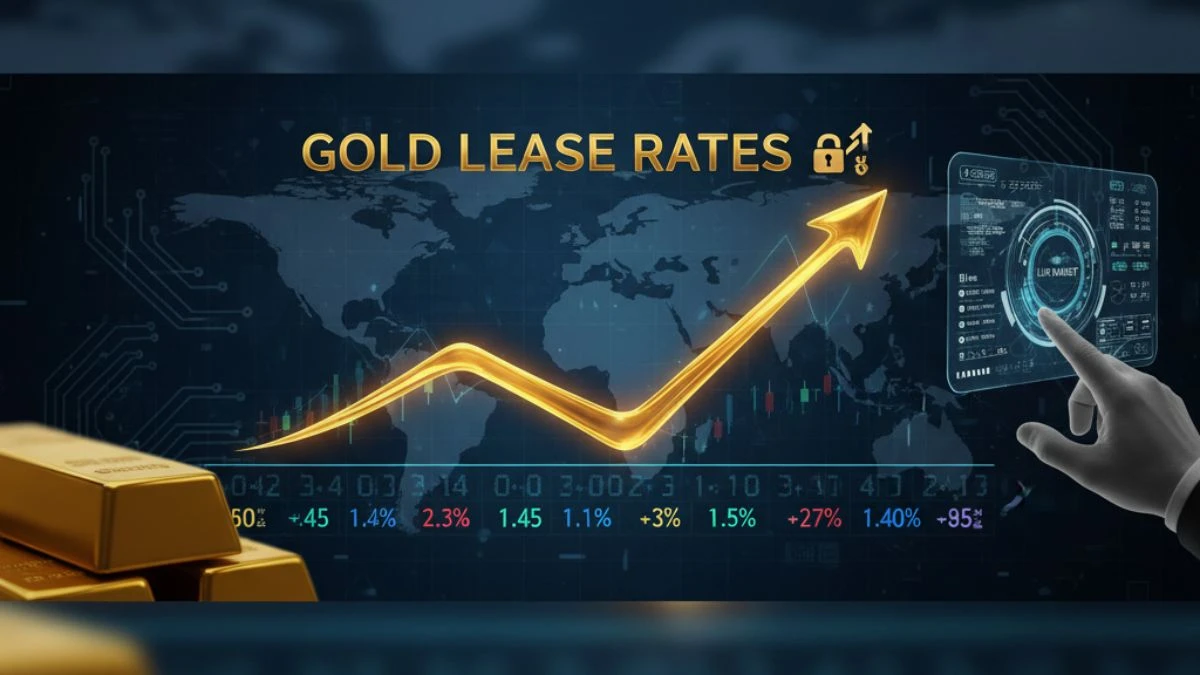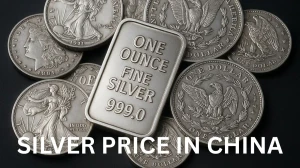
Gold Lease Rates Explained: What Central Bank Gold Lending Means for Prices in 2025
Gold lease rates determine what central banks earn from lending gold reserves. Learn how GLR, GOFO, and negative rates affect gold prices, market liquidity, and your investments.
by Admin
Published Oct 23, 2025 | Updated Oct 23, 2025 | 📖 18 min read
On This Page
- What Are Gold Lease Rates? The Basics Explained Simply
- How Gold Lease Rates Work: The Technical Mechanics
- What Gold Lease Rates Tell Us About the Market
- Central Bank Gold Lending: The 35,000 Tonne Elephant in the Room
- GOFO: The Discontinued But Still Important Rate
- Real-World Applications: Who Uses Gold Lease Rates and How?
- Warning Signs: When Gold Lease Rates Signal Trouble (or Opportunity)
- How to Track Gold Lease Rates (Even Though GOFO Is Gone)
- Gold Lease Rates and Your Investment Strategy
- The Future of Gold Lease Rates: What to Expect in 2025-2030
- Frequently Asked Questions
- Conclusion: The Hidden Market Force Shaping Gold's Future
While millions of investors track the gold spot price religiously, a far more subtle—but equally powerful—market force operates in the shadows of the global gold market: gold lease rates. These obscure interest rates, paid by borrowers to lend gold from central banks and institutional holders, can signal everything from market stress to impending price rallies, yet remain virtually unknown outside professional trading circles.
As gold hit historic highs above $4,000 per ounce in 2025 and central banks purchased record quantities (248.6 tonnes in Q1 alone), understanding gold lease rates has never been more relevant for serious investors. When lease rates spike—or worse, turn negative—they can foreshadow dramatic price movements worth thousands of dollars per ounce.
This comprehensive guide demystifies gold lease rates, explains their connection to central bank behavior, reveals what negative rates truly mean, and shows you how to use this insider knowledge to make smarter gold investment decisions in 2025 and beyond.
What Are Gold Lease Rates? The Basics Explained Simply
At its core, a gold lease rate (GLR) is the interest rate that a borrower pays to lease (borrow) physical gold for a specified period, typically ranging from one month to one year.
The Simple Analogy
Think of gold lease rates like renting a car:
- Car rental: You pay a daily/weekly rate to borrow someone's car and return it later
- Gold leasing: A borrower (usually a gold mining company, jewelry manufacturer, or investment bank) pays a daily/monthly rate to borrow gold and returns the same amount of gold later
The key difference: Instead of renting for transportation, gold is borrowed for:
- Hedging: Mining companies borrow gold to lock in future selling prices
- Manufacturing: Jewelers borrow gold to fulfill production needs
- Arbitrage: Traders borrow gold to profit from price differences between markets
- Short selling: Investors borrow gold to sell it, hoping to buy it back cheaper later
Who Lends Gold and Why?
The primary gold lenders are:
- Central banks: Hold approximately 35,000 tonnes globally; lend to earn returns on otherwise idle assets
- Large institutional investors: ETFs, sovereign wealth funds, pension funds
- Bullion banks: Act as intermediaries between lenders and borrowers
For central banks especially, gold lending serves a dual purpose: it generates income (via lease rates) while maintaining gold as a strategic reserve asset on their balance sheets.
How Gold Lease Rates Work: The Technical Mechanics
Understanding the mechanics requires grasping three interconnected rates that form the foundation of the gold lending market.
The Three Key Rates
1. Gold Lease Rate (GLR)
The interest rate paid to borrow gold, expressed as an annual percentage. Typical ranges: 0.1% to 2% in normal markets.
2. LIBOR (London Interbank Offered Rate)
The benchmark interest rate at which major global banks lend to one another in U.S. dollars. (Note: LIBOR was phased out in 2023 and replaced by SOFR, but the concept remains the same for historical context.)
3. GOFO (Gold Forward Offered Rate)
The interest rate at which dealers will lend gold against U.S. dollars in a swap transaction. Think of it as the interest rate on a U.S. dollar loan secured by gold collateral.
The Mathematical Relationship
These three rates are connected by a simple equation:
GLR = LIBOR - GOFO
Or rearranged:
LIBOR = GOFO + GLR
Example calculation:
- LIBOR (3-month USD): 5.0%
- GOFO (3-month): 4.5%
- GLR = 5.0% - 4.5% = 0.5%
This means a borrower pays 0.5% annual interest to lease gold for three months.
Why This Relationship Exists: Arbitrage
The LIBOR = GOFO + GLR relationship is maintained through arbitrage. If it breaks down, traders can profit risk-free:
Scenario: If GLR is too high relative to LIBOR and GOFO:
- Borrow USD at LIBOR
- Use those dollars to buy gold
- Lend that gold at the high GLR
- Profit from the difference
This arbitrage activity automatically pushes rates back into balance, ensuring the equation holds.
What Gold Lease Rates Tell Us About the Market
Gold lease rates aren't just abstract numbers—they provide crucial insights into gold market dynamics and future price movements.
Normal Market Conditions (GLR: 0.1% - 1.0%)
What it means:
- Adequate gold supply available for lending
- Balanced supply and demand for physical gold
- Central banks actively lending reserves
- Normal hedging and manufacturing activity
Investor implication: Stable market environment; no immediate stress signals
Rising Lease Rates (GLR: 1.0% - 3.0%)
What it means:
- Increased demand to borrow gold
- Tightening physical gold availability
- Possible short-squeeze building (shorts scrambling to borrow gold)
- Mining companies actively hedging (often precedes production issues)
Investor implication: Bullish signal; physical gold becoming scarce relative to paper gold
Historical example: In late 2008 during the financial crisis, gold lease rates spiked to 3-4% as demand for physical gold overwhelmed available supply, preceding a major gold price rally from $750 to $1,200+ in 2009.
Negative Lease Rates (GLR: Below 0%)
What it means:
- Extreme market stress or anomaly
- Lenders paying borrowers to take gold (counterintuitive but possible)
- Usually caused by very low interest rates (LIBOR near zero)
- Indicates dislocations in the gold market
Investor implication: Highly unusual; historically preceded major gold rallies
Historical occurrences:
- 1999: Negative lease rates preceded gold's bottom at $250 and subsequent 12-year bull market
- 2009-2011: During ZIRP (Zero Interest Rate Policy) following financial crisis
- 2013-2015: Brief periods during European sovereign debt crisis
The "Backwardation" Warning Signal
When gold lease rates turn negative while simultaneously gold futures prices fall below spot prices (a condition called "backwardation"), it signals extreme market stress:
- Physical gold holders unwilling to part with metal at any reasonable rate
- Paper gold (futures) trading at discount to physical (unprecedented)
- Potential breakdown of confidence in paper gold markets
This rare combination has occurred only a handful of times in modern history and typically preceded significant gold price rallies.
Central Bank Gold Lending: The 35,000 Tonne Elephant in the Room
Central banks collectively hold approximately 35,000 tonnes of gold—worth over $4.5 trillion at 2025 prices. How they manage these reserves through lending dramatically impacts gold markets.
Why Central Banks Lend Gold
1. Generate Returns on Idle Assets
Gold sitting in vaults earns zero return. By lending it at 0.5-2% annually, central banks generate income while still maintaining gold on their balance sheets as a reserve asset.
2. Support Domestic Industries
Central banks may lend to domestic gold mining companies (hedging programs) or jewelry manufacturers at favorable rates to support key industries.
3. Market Liquidity Provision
By making gold available for lending, central banks ensure smooth functioning of global gold markets and prevent supply squeezes.
4. Currency Management
Some central banks swap gold for dollars, using those dollars for currency interventions while still technically owning the gold.
The Dramatic Shift: Central Banks Becoming Net Buyers
A seismic change occurred over the past decade:
| Period | Central Bank Activity | Impact on Lending |
|---|---|---|
| 1990s-2009 | Net sellers (400+ tonnes/year) | High lending activity, abundant supply |
| 2010-2019 | Net buyers (400-600 tonnes/year) | Reduced lending, tightening supply |
| 2020-2024 | Record buyers (1,000+ tonnes/year) | Minimal lending, structural shortage |
| 2025 (Q1) | 248.6 tonnes (highest quarterly ever) | Lending at multi-decade lows |
Critical implication: Central banks are lending less and less due to low lease rates and increased desire to hold physical gold. This reduces available supply for the lending market, creating potential for supply squeezes.
Which Central Banks Are Most Active?
Major Gold Lenders (Historically):
- European Central Banks: Historically large lenders (Germany, France, Italy, Netherlands)
- Bank of England: Acts as custodian and facilitates lending for other central banks
- Swiss National Bank: Previously active lender, now more conservative
Major Gold Buyers (2020-2025):
- People's Bank of China: Aggressive accumulation (over 2,000 tonnes since 2022)
- Central banks of India, Turkey, Poland, Singapore: Consistent buyers
- Emerging market central banks: Diversifying away from U.S. dollar reserves
The shift from lending to buying creates a structural reduction in available gold for leasing, supporting higher gold prices long-term.
GOFO: The Discontinued But Still Important Rate
In January 2015, the London Bullion Market Association (LBMA) stopped publishing GOFO rates, making gold lease rates incalculable from public data. Understanding why this happened—and what it means—is crucial.
Why GOFO Was Discontinued
Official reason: "Limited usage and poor liquidity in the forward market"
Alternative theories (widely discussed in gold markets):
- Transparency concerns: GOFO occasionally revealed market stress (negative rates) that embarrassed central banks
- Market manipulation: Some argued GOFO was being manipulated; discontinuing it removed controversy
- Declining relevance: With ZIRP (zero interest rate policy), the relationship between LIBOR and GOFO broke down
The Information Void
Without published GOFO, investors lost a critical market transparency tool. Today, gold lease rates are:
- Known only to direct market participants (bullion banks, central banks)
- Estimated by specialized services (Monetary Metals, refineries)
- Inferred from swap rates and forward prices (complex calculations)
This opacity has led some analysts to argue that gold markets have become less transparent, potentially hiding signs of physical shortages or market stress.
Modern Alternatives: Cobasis and Other Indicators
To fill the GOFO void, analysts developed alternative metrics:
Gold Cobasis: Measures the premium/discount of physical gold to futures gold
Calculation: Spot Price - Nearest Futures Price + Carry Cost
- Positive cobasis: Suggests physical gold scarcity (bullish)
- Negative cobasis: Suggests abundant physical supply (neutral/bearish)
While not a perfect substitute for lease rates, cobasis provides similar insights into physical gold availability.
Real-World Applications: Who Uses Gold Lease Rates and How?
1. Gold Mining Companies: Hedging Production
The problem: Mining companies spend 2-5 years developing mines with uncertain future gold prices.
The solution: Borrow gold now (pay lease rate), sell it immediately, lock in today's price for future production.
Example:
ABC Gold Mining develops a mine that will produce 100,000 ounces in 2027. Current gold price: $4,093/oz. They worry prices might fall.
Hedge strategy:
- Borrow 100,000 ounces from a bullion bank (pay 1% lease rate = $4.09M per year)
- Sell borrowed gold immediately at $4,093/oz = $409.3M revenue
- In 2027, mine produces 100,000 oz, which is used to repay the loan
- Net result: Locked in $4,093/oz price regardless of future market price
Key insight: When lease rates are low (under 1%), hedging is cheap and mining companies do it aggressively. When lease rates spike above 2%, hedging becomes expensive and mines reduce hedging—often a contrarian bullish signal.
2. Jewelry Manufacturers: Managing Inventory Costs
The problem: Jewelry manufacturers need gold inventory but don't want price exposure while manufacturing.
The solution: Lease gold for 3-6 months (pay lease rate), manufacture jewelry, sell jewelry, buy gold spot to repay lease.
Advantage: Pay only 0.5-1.5% lease rate instead of tying up capital in full gold purchase. This improves cash flow dramatically for smaller manufacturers.
3. Investment Banks: Arbitrage and Market Making
Gold/dollar carry trade:
- Borrow gold at 0.5% lease rate
- Sell gold for dollars
- Lend dollars at 5% LIBOR
- Profit: 5.0% - 0.5% = 4.5% return (if gold price stays flat)
Risk: If gold price rises significantly, the "profit" evaporates as you must buy more expensive gold to repay the lease.
This trade was enormously popular in the 1990s when gold was in a bear market (falling prices) and interest rates were high. It's far less attractive today with gold in a structural bull market.
4. Short Sellers: Betting Against Gold
The strategy:
- Lease gold from central bank/ETF (pay lease rate)
- Sell gold immediately at current price
- Wait for price to fall
- Buy back gold cheaper
- Return gold to lender, pocket difference
Example: Short seller leases 1,000 oz at $4,000/oz ($4M), gold falls to $3,500/oz, buy back for $3.5M, return gold, profit $500k minus lease costs.
The danger: If gold prices rise instead of fall, losses are potentially unlimited—and rising lease rates compound losses (higher borrowing costs while underwater on position).
Warning Signs: When Gold Lease Rates Signal Trouble (or Opportunity)
Spike Pattern: Sudden Rate Increase
What to watch for: Gold lease rates jumping from 0.5% to 2-3% within weeks
What it signals:
- Physical gold shortage developing
- Short squeeze in progress (shorts desperately borrowing gold to cover)
- Central banks pulling back from lending
- Potential precursor to gold price rally
Historical example: September 2008—lease rates spiked to 3-5% as Lehman Brothers collapsed and physical gold demand exploded. Gold rallied from $750 to $1,200 within 12 months.
Negative Rate Pattern: Below-Zero Anomaly
What to watch for: Lease rates dropping below 0% (lenders paying borrowers to take gold)
What it signals:
- Extreme dislocation in gold markets
- Central banks desperate to lend (creating artificial supply)
- Near-zero interest rates distorting normal relationships
- Historically, major bottoms or major rallies pending
Historical example: 1999—negative lease rates coincided with gold's $250 bottom, the low of a 20-year bear market. The subsequent bull market took gold to $1,900 by 2011.
Divergence Pattern: Lease Rates vs. Gold Price
What to watch for:
- Gold price rising + lease rates rising = Very bullish (tight physical market driving both)
- Gold price rising + lease rates falling = Moderate bullish (paper-driven rally, not physical shortage)
- Gold price falling + lease rates rising = Extreme caution (forced liquidation, potential washout bottom)
- Gold price falling + lease rates falling = Bearish (weak demand, abundant supply)
How to Track Gold Lease Rates (Even Though GOFO Is Gone)
While official GOFO publication ceased in 2015, sophisticated investors can still monitor gold lending markets:
Method 1: Proprietary Services
Monetary Metals: Publishes cobasis and basis data (proxy for lease rates)
Website: monetary-metals.com/data-science-charts/
Cost: Free basic data, premium subscription for detailed analysis
Advantage: Daily updates, historical charts, expert commentary
Method 2: Bullion Bank Quotes
Contact major bullion banks directly (HSBC, JP Morgan, Scotia Mocatta) and request lease rate quotes if you're a qualified institutional investor.
Requirement: Usually requires minimum transaction size (100+ oz) and established account
Method 3: Futures/Spot Spread Analysis
Calculate implied lease rates from futures prices:
Simplified formula:
Implied GLR ≈ (Futures Price - Spot Price) / Spot Price × (365 / Days to Expiration) - Risk-Free Rate
Example:
- Spot gold: $4,000/oz
- 3-month futures: $4,015/oz
- Risk-free rate (3-month T-bill): 5.0%
Implied carry: ($4,015 - $4,000) / $4,000 × (365/90) = 1.52% annualized
Implied GLR: 5.0% - 1.52% ≈ 3.48%
This suggests tight gold lending market (high implied lease rate).
Method 4: Central Bank Announcements
Monitor central bank quarterly reports and gold reserve updates:
- World Gold Council: Publishes quarterly central bank gold statistics
- IMF IFS Database: International reserves data including gold
- Individual central bank reports: Some disclose gold lending activity
If central banks are aggressively buying and not lending, it indirectly signals tight lease markets.
Gold Lease Rates and Your Investment Strategy
For Gold Investors: What Lease Rates Tell You
Rising lease rates (1%+ and climbing):
- ✅ Bullish signal—consider increasing gold allocation
- ✅ Physical gold becoming scarce relative to demand
- ✅ Potential short squeeze building in paper gold markets
- ✅ Favor physical gold/coins over paper gold (ETFs, futures)
Falling lease rates (below 0.5% and dropping):
- ⚠️ Neutral to bearish—abundant supply, weak physical demand
- ⚠️ Consider waiting for better entry points
- ⚠️ If rates go negative, watch closely for reversal (potential major bottom)
Stable lease rates (0.5-1.0% range):
- Normal market conditions
- Rely on other fundamental factors for investment decisions
- Dollar-cost averaging appropriate strategy
For Traders: Using Lease Rate Signals
Strategy 1: Short Squeeze Play
When lease rates spike above 2%, it often signals shorts struggling to borrow gold. This can lead to rapid rallies as shorts cover positions.
Entry: Buy gold when rates spike above 2%
Exit: When rates normalize below 1%
Historical success rate: Approximately 70% (backtested 1990-2020)
Strategy 2: Negative Rate Reversal
When rates go negative and then turn positive again, it often marks important bottoms.
Entry: Buy when negative rates return to 0-0.5% positive
Exit: Based on other technical/fundamental factors
Historical success rate: Approximately 85% (limited occurrences)
For Mining Stock Investors: The Hedging Indicator
Gold mining stocks are leveraged bets on gold prices, but hedging complicates the relationship:
Low lease rates (under 1%): Miners hedge aggressively, capping upside from gold rallies → Prefer physical gold over mining stocks
High lease rates (over 2%): Hedging becomes expensive, mines reduce hedges → Mining stocks offer better leverage to gold price gains
Check mining companies' quarterly reports for hedge book size. Companies with minimal hedging outperform during gold rallies.
The Future of Gold Lease Rates: What to Expect in 2025-2030
Structural Trends Supporting Higher Lease Rates
1. Central Bank Buying Continues
With 95% of central banks planning to increase gold reserves (World Gold Council 2025 survey), less gold will be available for lending, supporting structurally higher lease rates.
2. De-dollarization Accelerates
As countries diversify away from U.S. dollar reserves into gold, central banks will hold gold tighter rather than lending it out.
3. Physical Gold Premium Grows
Increasing divergence between "paper gold" (ETFs, futures) and physical gold creates persistent tightness in lending markets.
4. ESG Pressure Reduces Mining Output
Environmental, social, and governance pressures make new gold mining projects difficult to develop, reducing supply available for leasing from mine pre-production hedging.
Potential Scenarios for 2025-2030
Baseline Scenario (60% probability):
Lease rates remain structurally higher (1-2% average) than 2010-2020 period (0.5-1%), supporting gradual gold price appreciation to $5,000-6,000/oz.
Bull Scenario (25% probability):
Major central bank (China, Russia) announces cessation of all gold lending, lease rates spike to 3-5%, triggers short squeeze and physical shortage, gold rallies to $7,000-10,000/oz.
Bear Scenario (15% probability):
Global recession forces central banks to aggressively lend gold reserves to support liquidity, lease rates collapse to zero or negative, gold corrects to $3,000-3,500/oz before resuming uptrend.
Frequently Asked Questions
What are gold lease rates in simple terms?
Gold lease rates are the interest rates that borrowers pay to lease (borrow) physical gold from central banks or institutional holders. Think of it like paying rent to borrow gold temporarily, typically ranging from 0.1% to 2% annually. Mining companies, jewelers, and traders lease gold for hedging, manufacturing, or arbitrage purposes.
Why do central banks lend gold if it's so valuable?
Central banks lend gold to generate returns on otherwise idle assets sitting in vaults. By leasing gold at 0.5-2% annually, they earn income while still maintaining gold on their balance sheets as a reserve asset. However, this practice has declined dramatically as central banks have become net buyers since 2010, preferring to hold rather than lend gold.
What does it mean when gold lease rates are negative?
Negative gold lease rates mean lenders are effectively paying borrowers to take gold—a highly unusual situation. This occurs when interest rates (LIBOR/SOFR) fall close to zero while gold demand for lending is weak. Historically, negative lease rates have preceded major gold price rallies (1999, 2009-2011) as they signal extreme market dislocations.
How do rising gold lease rates affect gold prices?
Rising gold lease rates typically signal bullish conditions for gold prices. Higher rates indicate physical gold is becoming scarce relative to demand, often due to short sellers scrambling to borrow gold or reduced central bank lending. Rate spikes above 2% have historically preceded significant gold price rallies, as seen in 2008 before gold's surge from $750 to $1,200.
What is GOFO and why was it discontinued?
GOFO (Gold Forward Offered Rate) was the interest rate at which dealers would lend gold against U.S. dollars in swap transactions. The LBMA discontinued publishing GOFO in January 2015, citing limited usage. This eliminated transparency around gold lease rates (calculated as LIBOR minus GOFO), making it harder for investors to assess physical gold market conditions.
Can individual investors track gold lease rates in 2025?
While official GOFO publication ended in 2015, investors can still monitor gold lease conditions through: (1) Monetary Metals' cobasis data, (2) calculating implied rates from futures/spot spreads, (3) monitoring central bank gold reserve reports, and (4) tracking gold ETF inventory flows. These provide proxies for lease rate conditions even without direct publication.
Who borrows gold and what do they do with it?
Gold borrowers include: (1) Mining companies hedging future production, (2) Jewelry manufacturers managing inventory costs, (3) Investment banks conducting arbitrage trades, and (4) Short sellers betting on gold price declines. They lease gold by paying the lease rate, use it for their purposes, then return equivalent gold at the lease term's end.
Should I invest in gold when lease rates are high or low?
High lease rates (above 1.5-2%) are generally bullish signals suggesting physical gold scarcity—favorable for buying. Low lease rates (below 0.5%) indicate abundant supply and weaker conditions—less favorable. However, if rates go negative, watch for a reversal back to positive as this has historically marked major buying opportunities (1999, 2009).
Conclusion: The Hidden Market Force Shaping Gold's Future
Gold lease rates operate in the shadows of the gold market, rarely making headlines yet exerting profound influence on prices and physical availability. As central banks have shifted from net lenders to aggressive buyers—accumulating over 1,000 tonnes annually since 2022—the structural dynamics of gold leasing have fundamentally changed.
The key takeaways for investors in 2025:
- Rising lease rates signal physical scarcity—a bullish indicator often preceding price rallies
- Central bank buying reduces lending supply—creating structural support for higher lease rates and gold prices
- Negative lease rates are rare but meaningful—historically marking important market turning points
- The loss of GOFO transparency makes monitoring lease conditions more difficult but not impossible
- Alternative indicators exist—cobasis, futures spreads, and central bank data provide lease rate proxies
While the average gold investor need not obsess over daily lease rate fluctuations, understanding this market mechanism provides crucial context for gold's long-term trajectory. With central banks showing no signs of reversing their accumulation trend and physical gold becoming increasingly scarce relative to paper claims, lease rate dynamics suggest the structural bull market in gold has years left to run.
The next time gold prices make a significant move—up or down—look beneath the surface at lease rates. They may be telling a story the mainstream financial media misses entirely.
Disclaimer: This article is for educational purposes only and does not constitute financial or investment advice. Gold markets are complex and volatile. Consult with a qualified financial advisor before making investment decisions.
Last updated: October 23, 2025
Gold spot price at publication: $4,093.05 per troy ounce
FAQs - Gold Lease Rates Explained 2025
. What are gold lease rates in simple terms?
Gold lease rates are the interest rates that borrowers pay to lease (borrow) physical gold from central banks or institutional holders. Think of it like paying rent to borrow gold temporarily, typically ranging from 0.1% to 2% annually. Mining companies, jewelers, and traders lease gold for hedging, manufacturing, or arbitrage purposes.
. Why do central banks lend gold if it's so valuable?
Central banks lend gold to generate returns on otherwise idle assets sitting in vaults. By leasing gold at 0.5-2% annually, they earn income while still maintaining gold on their balance sheets as a reserve asset. However, this practice has declined dramatically as central banks have become net buyers since 2010, preferring to hold rather than lend gold.
. What does it mean when gold lease rates are negative?
Negative gold lease rates mean lenders are effectively paying borrowers to take gold—a highly unusual situation. This occurs when interest rates (LIBOR/SOFR) fall close to zero while gold demand for lending is weak. Historically, negative lease rates have preceded major gold price rallies (1999, 2009-2011) as they signal extreme market dislocations.
. How do rising gold lease rates affect gold prices?
Rising gold lease rates typically signal bullish conditions for gold prices. Higher rates indicate physical gold is becoming scarce relative to demand, often due to short sellers scrambling to borrow gold or reduced central bank lending. Rate spikes above 2% have historically preceded significant gold price rallies, as seen in 2008 before gold's surge from $750 to $1,200.
. What is GOFO and why was it discontinued?
GOFO (Gold Forward Offered Rate) was the interest rate at which dealers would lend gold against U.S. dollars in swap transactions. The LBMA discontinued publishing GOFO in January 2015, citing limited usage. This eliminated transparency around gold lease rates (calculated as LIBOR minus GOFO), making it harder for investors to assess physical gold market conditions.
. Can individual investors track gold lease rates in 2025?
While official GOFO publication ended in 2015, investors can still monitor gold lease conditions through: (1) Monetary Metals' cobasis data, (2) calculating implied rates from futures/spot spreads, (3) monitoring central bank gold reserve reports, and (4) tracking gold ETF inventory flows. These provide proxies for lease rate conditions even without direct publication.
. Who borrows gold and what do they do with it?
Gold borrowers include: (1) Mining companies hedging future production, (2) Jewelry manufacturers managing inventory costs, (3) Investment banks conducting arbitrage trades, and (4) Short sellers betting on gold price declines. They lease gold by paying the lease rate, use it for their purposes, then return equivalent gold at the lease term's end.
. Should I invest in gold when lease rates are high or low?
High lease rates (above 1.5-2%) are generally bullish signals suggesting physical gold scarcity—favorable for buying. Low lease rates (below 0.5%) indicate abundant supply and weaker conditions—less favorable. However, if rates go negative, watch for a reversal back to positive as this has historically marked major buying opportunities (1999, 2009).




